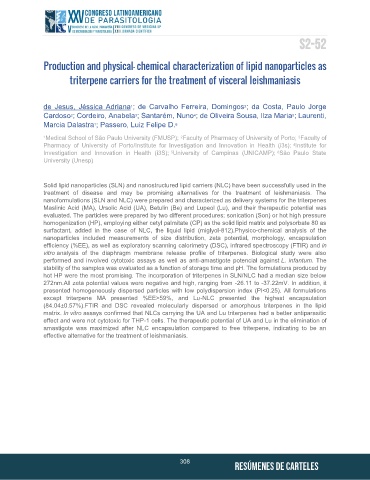Page 310 - Resúmen - XXV Congreso Latinoamericano de Parasitología - FLAP
P. 310
S2-52
Production and physical- chemical characterization of lipid nanoparticles as
triterpene carriers for the treatment of visceral leishmaniasis
de Jesus, Jéssica Adriana ; de Carvalho Ferreira, Domingos ; da Costa, Paulo Jorge
2
1
Cardoso ; Cordeiro, Anabela ; Santarém, Nuno ; de Oliveira Sousa, Ilza Maria ; Laurenti,
3
4
5
2
Marcia Dalastra ; Passero, Luiz Felipe D.
6
1
1 Medical School of São Paulo University (FMUSP); Faculty of Pharmacy of University of Porto; Faculty of
3
2
Pharmacy of University of Porto/Institute for Investigation and Innovation in Health (i3s); Institute for
4
Investigation and Innovation in Health (i3S); University of Campinas (UNICAMP); São Paulo State
5
6
University (Unesp)
Solid lipid nanoparticles (SLN) and nanostructured lipid carriers (NLC) have been successfully used in the
treatment of disease and may be promising alternatives for the treatment of leishmaniasis. The
nanoformulations (SLN and NLC) were prepared and characterized as delivery systems for the triterpenes
Maslinic Acid (MA), Ursolic Acid (UA), Betulin (Be) and Lupeol (Lu), and their therapeutic potential was
evaluated. The particles were prepared by two different procedures: sonication (Son) or hot high pressure
homogenization (HP), employing either cetyl palmitate (CP) as the solid lipid matrix and polysorbate 80 as
surfactant, added in the case of NLC, the liquid lipid (miglyol-812).Physico-chemical analysis of the
nanoparticles included measurements of size distribution, zeta potential, morphology, encapsulation
efficiency (%EE), as well as exploratory scanning calorimetry (DSC), infrared spectroscopy (FTIR) and in
vitro analysis of the diaphragm membrane release profile of triterpenes. Biological study were also
performed and involved cytotoxic assays as well as anti-amastigote potencial against L. infantum. The
stability of the samples was evaluated as a function of storage time and pH. The formulations produced by
hot HP were the most promising. The incorporation of triterpenes in SLN/NLC had a median size below
272nm.All zeta potential values were negative and high, ranging from -26.11 to -37.22mV. In addition, it
presented homogeneously dispersed particles with low polydispersion index (PI<0.25). All formulations
except triterpene MA presented %EE>59%, and Lu-NLC presented the highest encapsulation
(84.04±0.57%).FTIR and DSC revealed molecularly dispersed or amorphous triterpenes in the lipid
matrix. In vitro assays confirmed that NLCs carrying the UA and Lu triterpenes had a better antiparasitic
effect and were not cytotoxic for THP-1 cells. The therapeutic potential of UA and Lu in the elimination of
amastigote was maximized after NLC encapsulation compared to free triterpene, indicating to be an
effective alternative for the treatment of leishmaniasis.
308
RESÚMENES DE CARTELES

